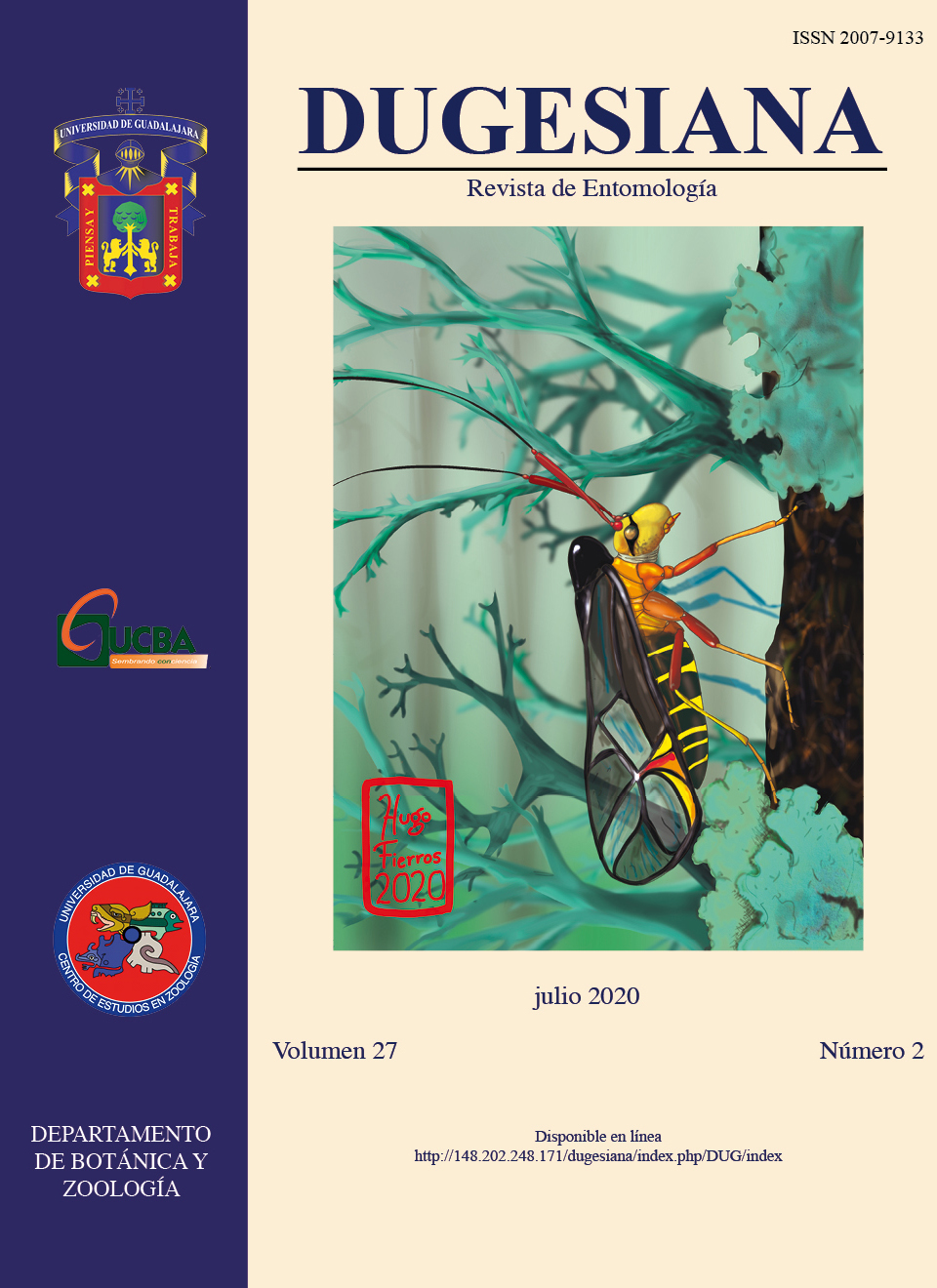The <em>Trichadenotecnum corniculum</em> species group from Thailand (Psocodea: Psocidae)
DOI:
https://doi.org/10.32870/dugesiana.v27i2.7111Keywords:
Psocoptera, taxonomy, new species, male genitalia, Oriental regionAbstract
Five new species of the corniculum species group of the psocid genus Trichadenotecnum Enderlein, T. alfonsoi, T. lingens, T. palmula, T. affinifelix and T. separatum were described from Thailand. These species share a couple of male genital apomorphies with the other Oriental species of this species group recorded from China, Hong Kong, Malaysia, Singapore and Indonesia. The Japanese species of the corniculum group are considered to form a different clade placed to the sister of the Oriental species.References
Kentjonowati, E.S. and T.R. New. 2005. The genus Trichadenotecnum (Insecta: Psocoptera: Psocidae) in Sumatra, Indonesia, with description of thirteen new species. Records of the Australian Museum 57: 15–38.
Li, F. 2002. Psocoptera of China. Science Press, Beijing, 1976 pp.
New, T. R. and I.W.B. Thornton. 1976. Psocomorpha (Pso¬coptera) from the Malayan Peninsula. Oriental Insects 9: 375–418.
Thornton, I.W.B. 1961. The Trichadenotecnum group (Pso¬coptera: Psocidae) in Hong Kong, with descriptions of new species. Transactions of the Royal Entomological Society, London 113: 1–24.
Yoshizawa, K. 2003. Two new species that are likely to rep¬resent the most basal clade of the genus Trichadenotec¬num. Entomological Science 6: 301–308.
Yoshizawa, K. and C. Lienhard. 2004. Systematics of Trichadenotecnum (Psocoptera: Psocidae) in Hong Kong. Publicaciones Especiales Instituto de Biología, UNAM (20): 121–149.
Yoshizawa, K. and C. Lienhard. 2015a. The alinguum group, a new species group of the genus Trichadenotec¬num, with descriptions of two new species from Thai¬land (Psocodea: ‘Psocoptera’: Psocidae). Insecta Mat¬sumurana, new series 71: 179–188.
Yoshizawa, K. and C. Lienhard. 2015b. Synonymy of Cryp¬topsocus Li with Trichadenotecnum Enderlein (Insecta: Psocodea: ‘Psocoptera’: Psocidae) and description of three new species. Zootaxa 3957: 480–488.
Yoshizawa, K., C. Lienhard, and A.B. Idris. 2014. Trichade¬notecnum species from Peninsular Malaysia and Singa¬pore (Insecta: Psocodea: ‘Psocoptera’: Psocidae). Zoot¬axa 3835: 469–500.
Yoshizawa, K., I. Yao, and C. Lienhard. 2016. Molecular phylogeny reveals genital convergences and reversals in the barklouse genus Trichadenotecnum (Insecta: Psoco¬dea: ‘Psocoptera’: Psocidae). Molecular Phylogenetics and Evolution 94: 358–364.
Yoshizawa, K., K.P. Johnson, I. Yao, J.A. Casasola González, E. Bess, and A.N. García Aldrete. 2017. Mul¬tiple trans-Beringia dispersals of the barklouse genus Trichadenotecnum (Insecta: Psocodea: Psocidae). Bio¬logical Journal of the Linnean Society 121: 501–513.
Published
Issue
Section
License
1. Proposed policy for open access journals
Those authors who have publications with this journal, accept the following terms:
- The authors will retain their copyright and will guarantee to the journal the right of first publication of their work, which will be simultaneously subject to the Creative Commons Recognition License, which allows third parties to share the work whenever their author is indicated and His first publication is this journal.
- Authors may adopt other non-exclusive license agreements to distribute the version of the published work (eg to be deposited in an institutional telematic file or published in a monographic volume) provided the initial publication is indicated in this journal .
Authors are encouraged and encouraged to disseminate their work through the Internet (eg in institutional telematic files or on their web page) before and during the sending process, which can produce interesting exchanges and increase appointments Of the published work. (See The effect of open access).
2. Proposed policy for journals that offer open deferred access
Those authors who have publications with this journal, accept the following terms:
- The authors will retain their copyrights and will guarantee to the journal the right of first publication of their work [SPECIFY PERIOD OF TIME], which will be simultaneously subject to the Creative Commons Recognition License that allows third parties to share the work always That its author and his first publication be indicated this journal.
- Authors may adopt other non-exclusive license agreements to distribute the version of the published work (eg to be deposited in an institutional telematic file or published in a monographic volume) provided the initial publication is indicated in this journal .
- Authors are encouraged and encouraged to disseminate their work through the Internet (eg in institutional telematic files or on their web page) before and during the sending process, which can produce interesting exchanges and increase appointments Of the published work. (See The effect of open access).




